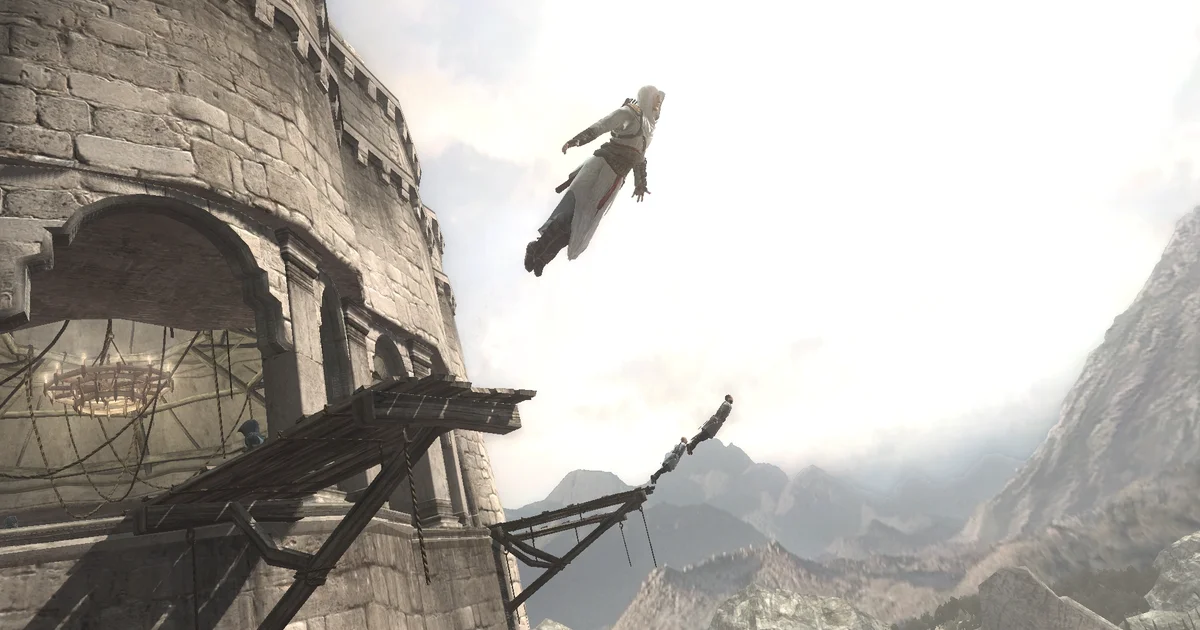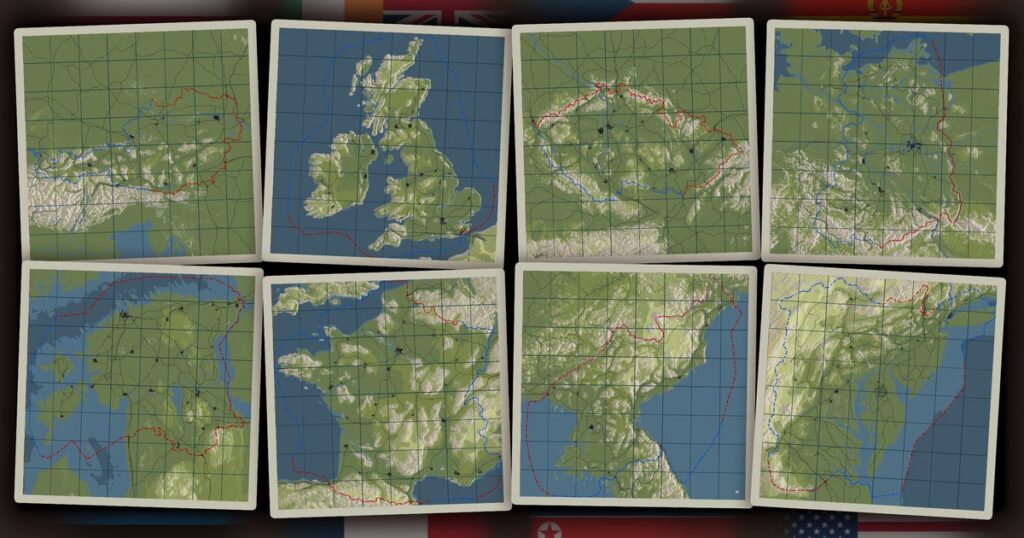Maybe five or ten years ago, people were completely sick because of the climbing towers in Ubisoft games. We still have? I’m not sure. If you have never shrunk one of these places, maybe because you have recently come from Mars, let me start you on the ground floor. The open world tower mechanism comes from Assassin Creed initially in 2007, and is a simple and satisfied storytelling round every year. It happened like this: You follow the tower on the horizon, you chase and shoulder over the city towards it, you enjoy the cry later – all the animations of Parkour, the wind around your ear when the urban context fades – and then you get a good look.
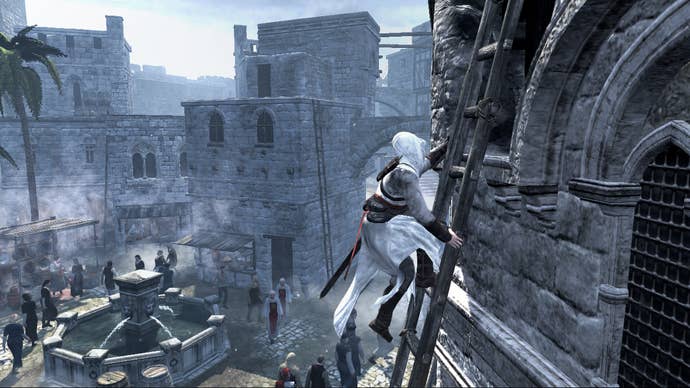
The towers used to be all the wrath between the open world, especially when combined with the regional -based design. The tower loop creates a reassuring foundation to explore, perhaps to the point where there is no real discovery that happens: it gives you a goal immediately whenever you get lost to the territory that has not been discovered. But the popularity of Tower-Climbing has certainly been considered contempt. I have mocked the towers, masts and like myself in many reviews of Ubiworld since 2010. However, recently, I found myself thinking that it was a way about Assassin Creed’s summit, the strange thing in the way the sequel was wasted by minimizing the old frame of Assassin Creed.
It is easy to forget that Assassin Creed, to some extent, is said to feel not gorgeous but fake. The original game describes the control of your avatar is “puppeteering”, with the control button layout corresponding to the hands, head and legs. For all Parkour’s fluency, there is a colorful embarrassment about how it thinks about the video game option – a feeling of the string strings that speak a larger storyline, in essence, there is no other choice. Assassin Creed is all about puppets are also puppets, a Ligottian script if one. It dangling the idea that history is a sand box in which “nothing is true, everything is allowed”, but also confirmed that you use this agency to “synchronize” with a certain life of another character.
You need to “synchronize” because this is really not a historic simulation. It is a simulation of a historical simulation. You are plugged into Animus, a strange VR machine currently invented by Abstergo to replace Ubisoft’s author to extract and regenerate “genetic memories”, which your ancestors passed down. The game’s report is a major synchronization act: imprisoned by Abstergo, the main character Desmond Miles must recreate a few days in the life of Assassin Altaïr IBN-LA’AHAD in the 13th century, chewing through a memory menu to enhance animation and finally, access to the company’s understanding. In the process, the main mechanisms such as stealth, NPC killing or dealing with damage are simulated, although on the outside, such as continuous rituals or interrupting between Desmond and Altaïr. It is all in the name of the one assembly, the real history and allowed that Abstergo requires to fulfill their outstanding ambitions.
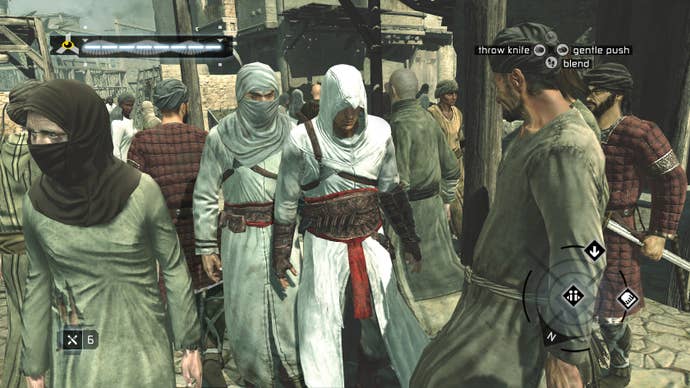
Given that blockbuster games often want to “immerse yourself”, convince you to forget that you are interacting with a device to deepen the flow state, I am fascinated by the insolence of Assassin Creed that you work through the distance between players and simulation. It requires you to “play well” not only to make progress, but also to prevent the world from flaking to WhiteBox. In other words, Assassin Creed dramatic a period between actions like the game required and the player is not satisfied with those expectations – whether through the search of the input or perhaps, through positive disobedience.
The “disobeying” against the simulation creators is not a very coherent ideal in a game designed to be “hacked”, giving QTE “malfunction” to make you tease in scenes. But this is not, for me, reducing the conspiracy of synchronization as a practical practice of a “inside” representative. There are many things that other designers can achieve here, I think, if they are provided with the rope you often do not receive from Triple-A manager. Specifically, I was impressed by the synchronization characteristic for the loop of the tower and, I dared to say, giving it a certain complexity of poetry. It is not only about synchronizing people through different periods, but also combining the aspects of symbols and metaphors.
The climbing tower in Assassin Creed is one of the ways you synchronize. That’s what you are doing when you expand the map: Consolidate the clamping of technology in the Middle Ages as if driving in a piton. But there is also a feeling that you and the main characters are involved in a form of synchronization that ends more openly-you are organizing and unifying these “puppets” like literary devices, instead of regaining memories from a double twisted chain.
The synchronization point itself is usually a small ray protruding from the top of the tower, with a eagle lying on it. Synchronized, and the viewing mode is outside, imitating Eagle’s flight is disturbed around the tower. “Altaïr” is an Arabic name derived from “Al -:” birds ” – I read that it mentioned specifically to the birds hunting. So, in a sense, when you climb the synchronization point, you are synchronizing Altaïr with Al-Tair. You are performing the exams of the name of Altaïr, reconciliating the assassin with his prototype.
You are doing all this, again, when Desmond is synchronized with Altaïr. The name “Desmond” does not have any poultry resonance, as I can say – Ubisoft Montreal writers may have taken it from the air at a lunch. But I found “synchronization” because I have redefined a process of inviting to the point where it is difficult to resist the expansion of Animus bandwidth – remember, “everything is allowed” – and stress to combine more data. In this process, synchronization once again becomes something rather than unlocking the rhythm of the map content, like string the stars together into constellations.
As an appropriate noun, “Desmond” can be traced to Mo Muman, a goddess of Mother Gaelic was held for personalization of Munster Ailen province. According to legend, Mo Muman has strode to the top of Sliabh a Iolair, the Irish for “Eagle Mountain”, to see the surrounding landscape. Perhaps Desmond is such a sovereignty, not only a man climbing into the body of another man climbing into the body of an eagle, but the architecture and geography of the open world being trampled and revealed by Altaïr.
Among the things that ruined poetry here is that, according to that folk story, I have just been caught from Wikipool, Mo Muman not only saw the scenery from Eagle Mountain, but lingered because of a completely strange anger, engraved with big mountains through the terrain. It is difficult to think about a parallel Assassin Creed there, but perhaps we can rescue the synchronization of decay by waving some implies to the structure of the transmission and the yellow straw of the weeds waiting to block the altaïr self.
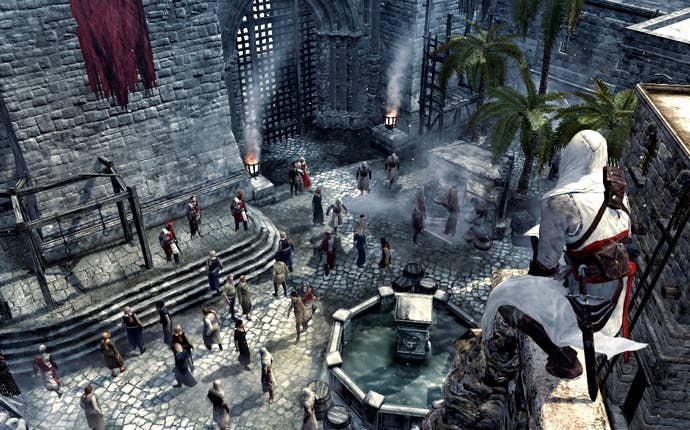
Of course, those hunting dogs are the hidden heroes of the assorted tower loop. Replaced in the later open worlds by Ziplines and Gliders, they are important shortcuts in a game that makes the dog’s absolute dinner from climbing down, with hand -held forever grabbing your fingers. Falling from a tower in Assassin’s Creed is an irresistible Crescento, and it is all thanks to those dried grasses, always there to make you provide you from the birds obsessed with birds, and always deny your autumn damage no matter how far you fall.
Those magical “Eagle Dives” are designed to be “reliable” rather than “reality”, according to the original Alex Drouin AC animation director. I found a reference about the “belief” APT here, in those diving eagles called in the game, it was a “leap of battle of faith”. Calling “faith” shows that this is Assassin Creed at least “right” and “allows” the most, because the action in faith is action without sure. But if there is one thing that Assassin Creed ensures that when you jump from a synchronized point, you will find a pile of hay below. In this process, the feeling of elegance, capable of connecting the network that I have just identified as a component of climbing collapsed into certainty, design.
To be fair, an early scene do The feature of a leap of faith ends in the disaster. In the beginning, you and two other assassins rushed down from a tower simultaneously to show a Templar general invading that fraternal love was not afraid of death. One of your brothers is screaming with a broken leg, but this is simply an excuse of the level scenario for Altaïr without people accompanying: from that time, the drum Animus interface of the lesson that you will always appear from straw is not hurt.
Imagine if you are informed that 1% of the chance of any climbing and the “dance of faith” will be wrong. How many percentage do they need, before the “faith” becomes a significant element of uniformity of the tower? And what can bring the idea of ”synchronization” is imagination and interpretation, instead of exploiting – a constellation of artistic and historical potentials? I wonder if Ubisoft/Abstergo can design assassin’s beliefs in a way that makes the animation operating less than the docile content consumption, and more than a risk process when tinkering with a FRETFUL simulation and pursuing its eccentric tricks – far beyond advertising such as “hack”.
I don’t think the upcoming assassin of Assassin Creed Shadows or any other contemporary Ubiworld has a lot of appetite for such scammers. It is not a kind of meaningless shareholder of Pie, especially right now, although Shadows is not aimed at restarting the animated storyline of the series. But perhaps this is a pile of hay that a group develops, less inhibited can enter, 17 years.
